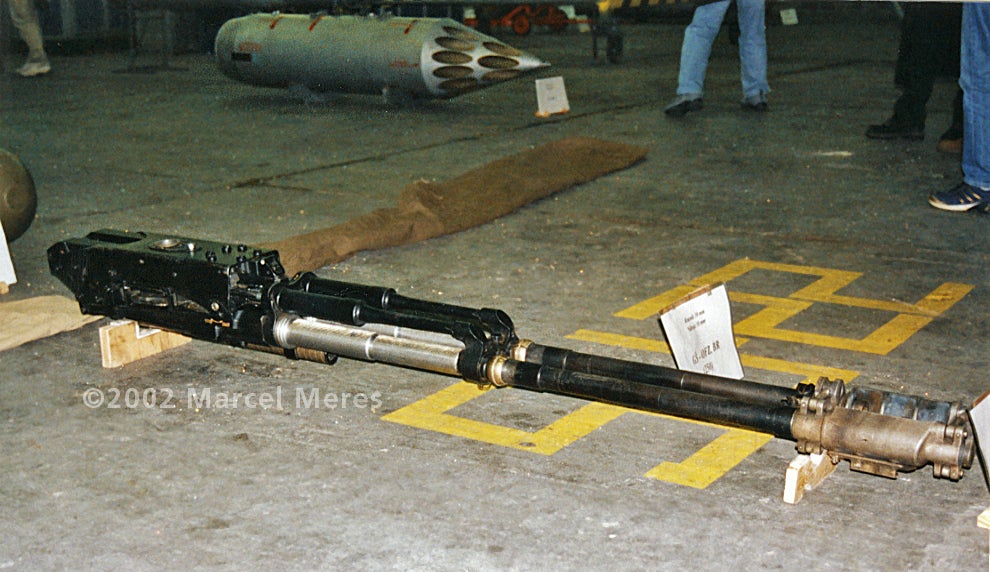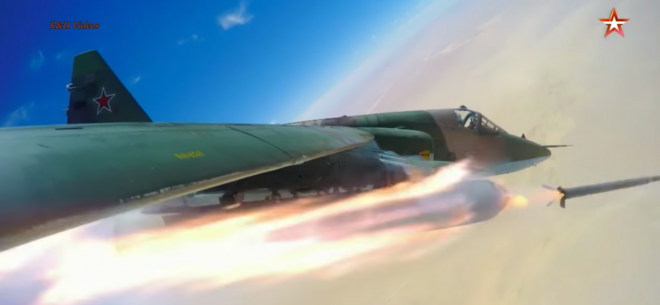The A-10 “Warthog” attack aircraft is beloved by pilots and gun enthusiasts alike, and not the least because of its powerful 30mm GAU-8 Gatling cannon. On the other side the Cold War, though, another aircraft was developed with matched an equally rugged and dependable airframe to an equally fearsome cannon: The Sukhoi Su-25 is called the “Frogfoot” by NATO, but to those who fly it and those who depend on it alike, it is the “Grach” (Грач, “Rook”). This red bird of death has overseen battlefields from Afghanistan to Syria, packing rockets, missiles, and its own potent 30mm gun. It is a twin engined jet with a pragmatic appearance, somewhat smaller than the A-10, and designed more as a generalist attack aircraft than a direct counter to enemy armor. The concept behind the Su-25 goes all the way back to before World War II, when the Soviet Union was exploring attack aircraft as part of a program that eventually led to the famous Il-2 Sturmovik. A tactical aircraft that can carry bombs, guns, and rockets in direct support of infantry was a concept that the Russians pioneered, and which had its baptism in fire on the Eastern Front of WWII against the Germans. Today, the Su-25 carries on that legacy in service with the Russian Federation and 22 other countries. But this is a gun blog, so let’s talk about its gun.

The Su-25’s powerful, fast-firing, and lightweight GSh-30-2 cannon. Image credit: Marcel Meres, used with permission.
Like the A-10, the Su-25 packs a powerful 30mm fast-firing cannon, but there the similarities between the two guns end. While the A-10 uses the electrically-driven GAU-8 Gatling cannon, the Su-25’s gun is based on the Gast principle, which is little if at all used in the West. The Gast principle uses two barrels and actions side-by-side, with each moving parts group connected to the other via a two-ended lever arm connected to a central pivot point. When one barrel fires, it causes its action to move rearward, which forces the other action forward, feeding a round into the second barrel, which then fires. This means each action acts as an accelerator for the other, enabling extremely high rates of fire. How high? The Su-25’s GSh-30-2 cannon has an approximate rate of fire of 3,000 rounds per minute, comparable to the 3,900 RPM of the GAU-8. The Gast principle comes with substantial advantages: It is far simpler than the Gatling principle, and due to mean gas-driven does not need any “spin up” like a Gatling.
Also, because it uses only two barrels in a single housing, a Gast gun can be made as light as 2 times the weight of as a single-barreled cannon, while Gatlings must be five to seven times as heavy. For comparison, the GSh-30-2 Gast gun is only 2.3 times the mass of the single-barreled GSh-301 (used in the Su-27 and MiG-29 fighters), while the GAU-8 is 6.1 times the mass. In an attack aircraft capable of carrying thousands of kilograms of ordnance, this is only a small advantage, but the efficiency of the GSh-30-2 versus its Western counterpart is still notable. However, the GSh-30-2 does have some disadvantages. When encountering a dud round, the electrically-driven GAU-8 simply cycles on through. With a gas operated gun, this would normally cause a jam that would stop the gun until the aircraft landed. However, the GSh-30-2 includes a system of blank cartridges (1 per barrel) which can restart the gun if it misfires. Compared to the A-10, the Su-25 carries a much lower ammunition load – 250 rounds versus 1,174 rounds for the A-10. This lower ammunition load has to do with differences in the tactics of the two nations. While the US saw the gun and the Maverick missile as the primary weapons of the A-10, the Soviets considered the gun auxiliary to the Su-25’s primary weapons, which were at the time unguided rockets, bombs, and guided missiles like the Kh-25ML.

Su-25 on static display, with a full wingload of empty B-8M1 rocket pods. In practice, this would mean a combat load of 160 80mm rockets, each one producing an explosion equivalent to a 105mm artillery shell.
Unlike the GAU-8, the GSh-30-2 is braked, allowing the center of fire to be slightly offset from the centerline of the aircraft. High explosive incendiary (ОФЗ, OFZ), high explosive incendiary tracer (ОФЗТ, OFZT), armor piercing high explosive (БР, BR), and “multi-element” high explosive fragmentation (МЕ, ME) rounds can be carried. This arguably increases the efficiency of Su-25 fire versus the A-10, which has only depleted uranium armor piercing incendiary (API), high explosive incendiary (HEI), and training practice (TP) rounds available. Restrictions on the use of ammunition with depleted uranium projectiles means that, in practice, the GAU-8 typically fires a mix of HEI and inert TP ammunition.
Once upon a time, footage of the elusive Russian Su-25 Rook was few and far between, but for us in 2017 that has all changed in recent years, with footage coming out of Russian action in Syria, as well as of Ukrainian Su-25s flying in the War in Donbass.
 Your Privacy Choices
Your Privacy Choices


